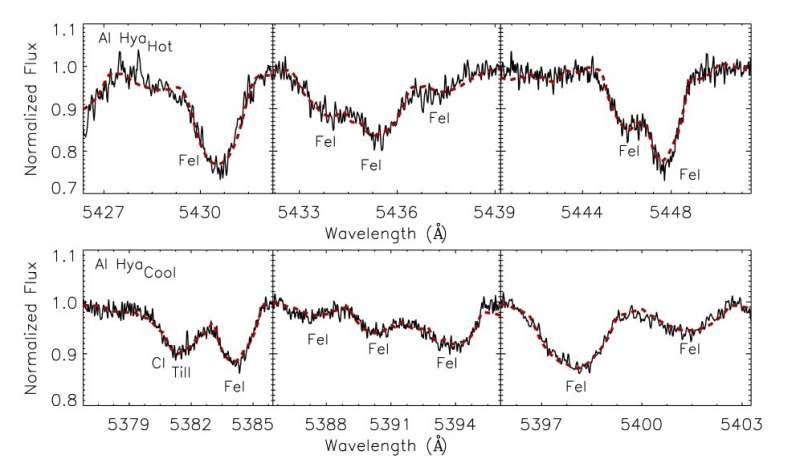by Tomasz Nowakowski , Phys.org

An international team of astronomers has performed a comprehensive spectroscopic and photometric study of a pulsating eclipsing binary star known as AI Hya. Results of the study, published January 11 on the arXiv pre-print server, deliver important insights into the nature of this system.
Eclipsing binaries (EBs) are systems showing regular light variations due to one of the stars passing directly in front of its companion. In EBs, the orbit plane of the two stars lies so nearly in the line of sight of the observer that the components undergo mutual eclipses. Such systems can provide direct measurement of the mass, radius and effective temperature of stars.
Pulsating stars are variables in which brightness variations are due to changes in the area and temperature of the star's surface layers. Some types of pulsating stars, such as Beta Cepheids, Delta Scuti stars, and Gamma Doradus stars, are also found in EBs.
Located some 2,000 light years away, AI Hya is an eclipsing binary with a Delta Scuti component consisting of a F2m and F0V star. It has an eccentric orbit and an orbital period of approximately 8.29 days. Given that to date no high-resolution spectra has been carried out for AI Hya, a group of astronomers led by Filiz Kahraman Alicavus of the Çanakkale Onsekiz Mart University in Turkey conducted a detailed photometric and spectral analysis of this system in order to unveil its true nature.
"In this study, we present a detailed analysis of the pulsating detached eclipsing binary system AI Hya which was studied by two independent groups with different methods. We carried out a spectroscopic survey to estimate the orbital parameters via radial velocity measurements and the atmospheric parameters of each binary component using the composite and/or disentangled spectra," the researchers wrote in the paper.
The analyzed data were collected using NASA's Transiting Exoplanet Survey Satellite (TESS) and various ground-based observatories. The study found that the more luminous component of AI Hya is a massive (2.09 solar masses), cool and chemically normal star, about 3.86 times larger than the sun, while the hotter component is a slightly metal-rich object with a radius of about 2.76 solar radii and a mass of some 1.95 solar masses.
The initial orbital period of AI Hya was determined to be 8.34 days, while its initial orbital eccentricity was estimated to be 0.24. The age of the system was calculated to be around 850–860 million years.
The astronomers underlined that regarding the evolutionary status of AI Hya, both its components are inside the Delta Scuti instability strip. According to the determined age, they assume that this system is in an important evolutionary phase in terms of binary evolution.
"The rapidly evolving massive component will begin the mass transfer process to the less massive one approximately 20 million years from now. This situation could cause significant variations in the oscillation properties," the authors of the paper predict.
More information: F. Kahraman Alicavus et al, Comprehensive spectroscopic and photometric study of pulsating eclipsing binary star AI Hya, arXiv (2023). DOI: 10.48550/arxiv.2301.04409
Journal information: arXiv
© 2023 Science X Network
Citation: Pulsating eclipsing binary AI Hya investigated in detail (2023, January 19) retrieved 22 January 2023 from https://ift.tt/6k01ozI
This document is subject to copyright. Apart from any fair dealing for the purpose of private study or research, no part may be reproduced without the written permission. The content is provided for information purposes only.
from Hacker News https://ift.tt/6k01ozI
No comments:
Post a Comment
Note: Only a member of this blog may post a comment.